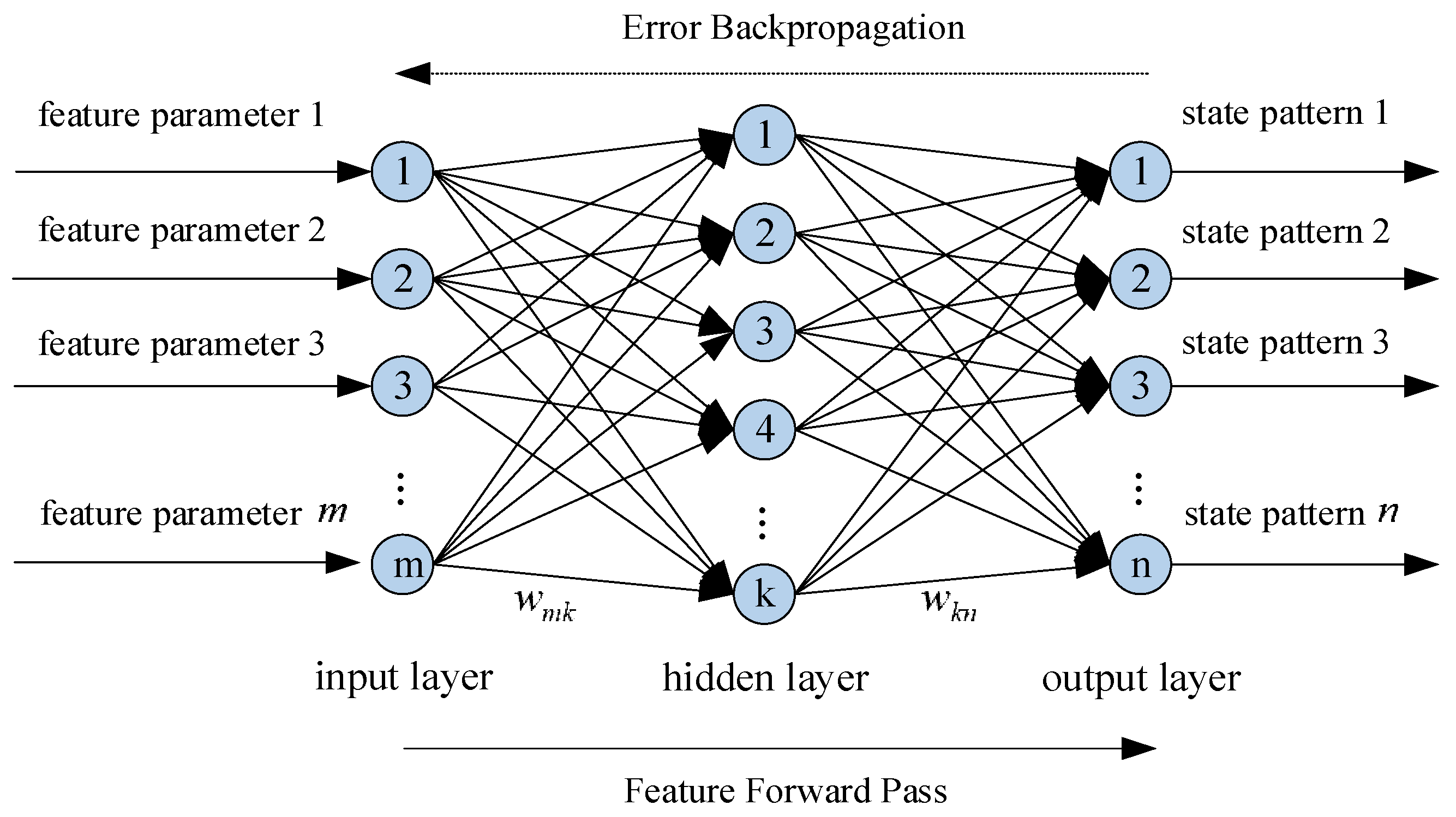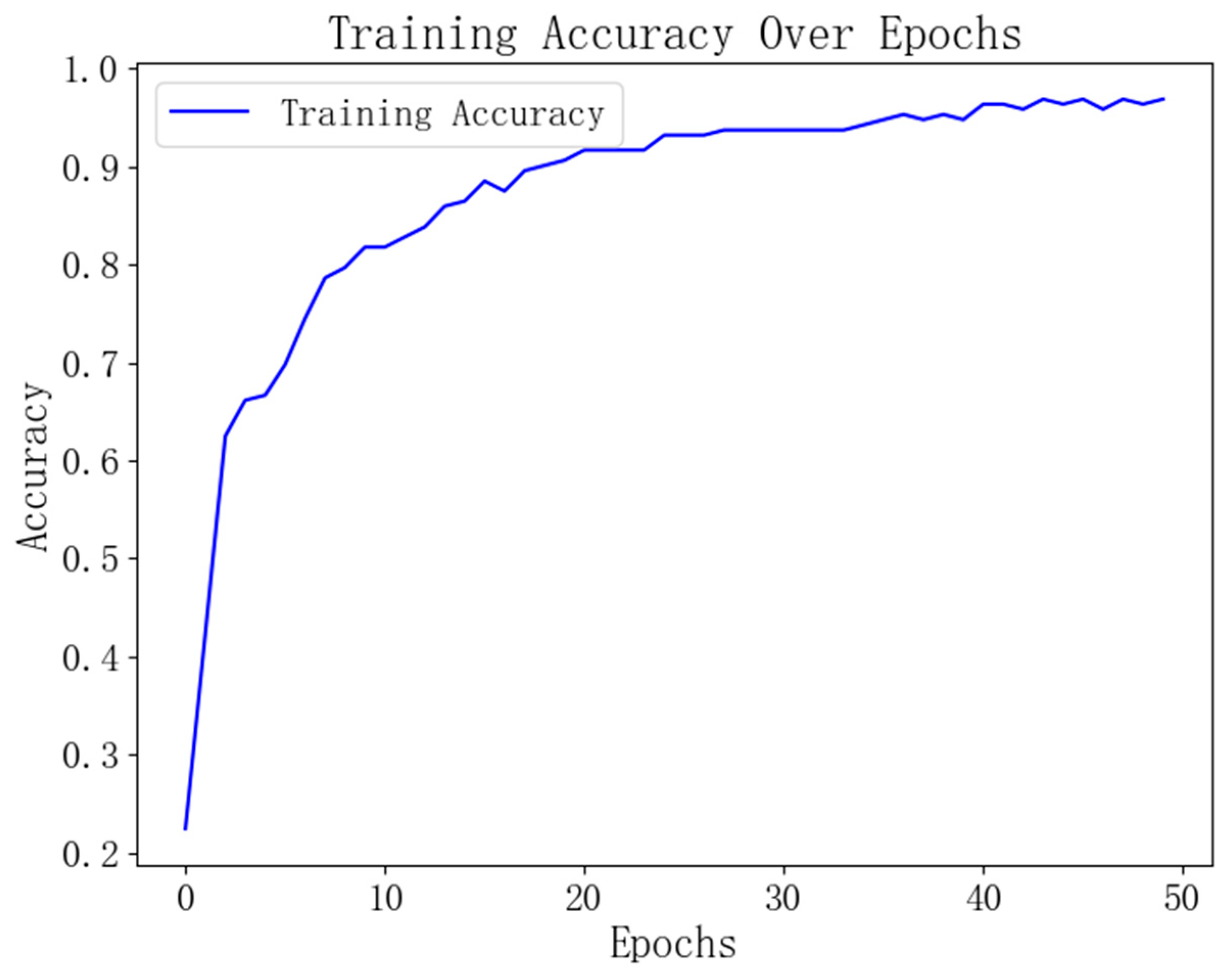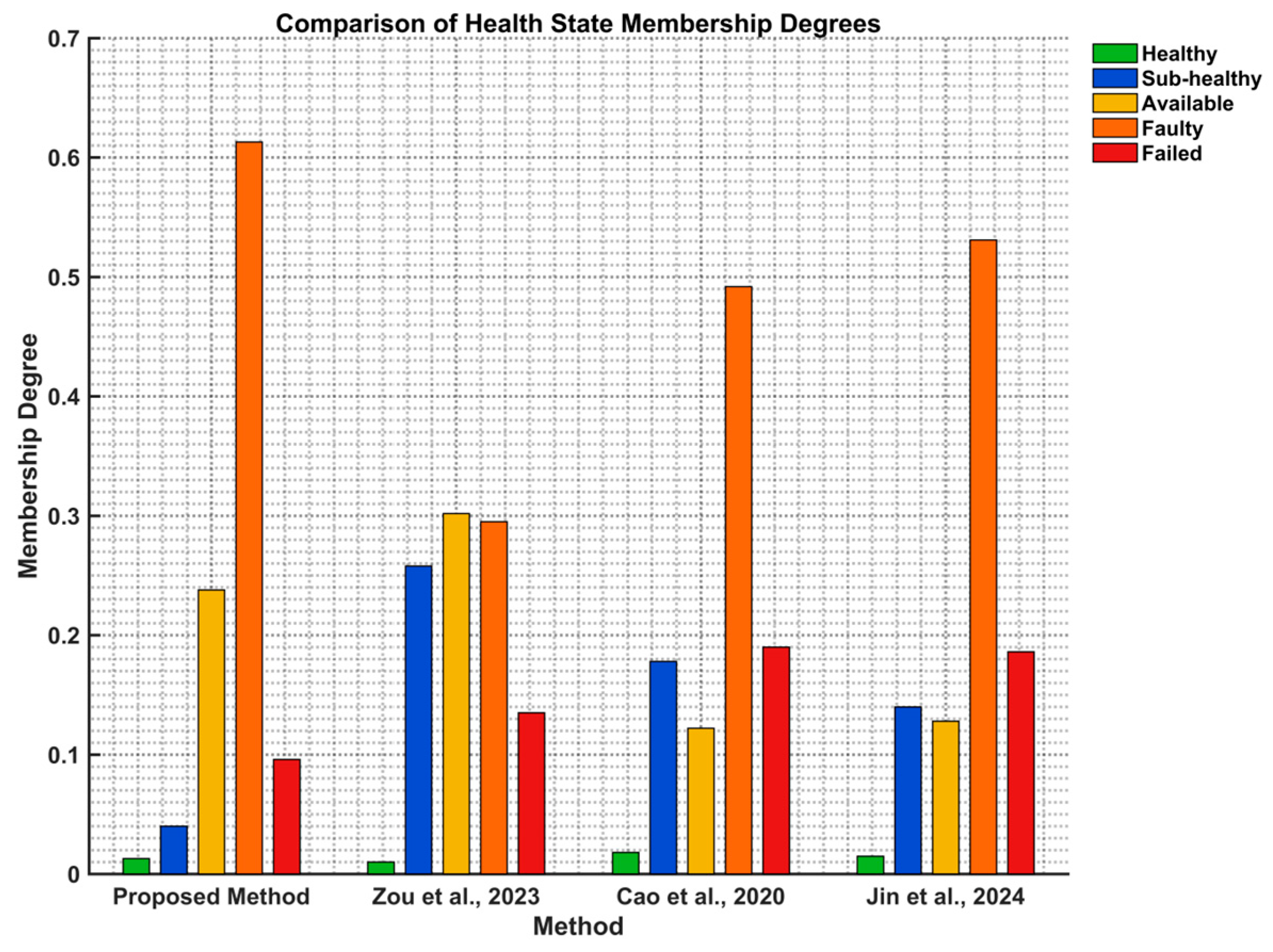Research on Ship Equipment Health State Assessment Method Based on BP Neural Network-Random Forest (BP-RF) and Combined Weighting
Abstract
1. Introduction
2. State Pattern Diagnosis of Ship Equipment Based on the BP-RF Model
2.1. BP Neural Network
2.2. Random Forest (RF) Algorithm
2.3. BP-RF Diagnostic Model
3. Determination of State Pattern Probability Weights
3.1. Subjective Weights Based on the G1 Method
3.2. Objective Weights Based on the Grey Relational Analysis Method
3.3. Combination of Weighting
4. Ship Equipment Health State Assessment
4.1. Health State Grading
- (1)
- Healthy: All parameters are far from the threshold or close to the standard value, ensuring the achievement of all specified functions. The probability of being in a fault combination state pattern is close to 0, allowing for an extended maintenance cycle;
- (2)
- Sub-healthy: Some parameters fluctuate within a certain range above and below the standard value but have not reached the threshold. The equipment can still perform all specified functions well, and the probability of being in a fault combination state pattern is low, allowing for an extended maintenance cycle;
- (3)
- Available: Some parameters deviate significantly from the standard value but have not yet reached the threshold. The equipment can only complete certain primary functions, and the probability of being in a fault combination state pattern is moderate, allowing for a slightly shortened maintenance cycle;
- (4)
- Faulty: Some parameters exceed the threshold, resulting in a significant loss of function. The probability of being in a fault combination state pattern is high, and some faults may have already occurred. The maintenance cycle must be shortened, and condition-based repairs must be performed;
- (5)
- Failed: Multiple parameters severely deviate from the standard value and exceed the threshold, leading to a complete loss of function. The probability of being in a fault combination state pattern is extremely high, with multiple simultaneous faults occurring. Immediate repairs are required.
4.2. Establishment of Health State Membership Function
4.3. Process of Health State Assessment
5. Case Analysis
5.1. Data Analysis and Preparation
5.2. State Pattern Diagnosis
5.2.1. Model Parameter Settings
5.2.2. Analysis of Model Diagnostic Results
5.2.3. Diagnostic Performance Comparison and Evaluation
5.2.4. State Pattern Probabilities Output
5.3. Calculation of Health State Membership Degree
5.4. Determination of State Pattern Weights
5.4.1. G1 Method for Determining Subjective Weights
5.4.2. Grey Relational Analysis Method to Determine Objective Weights
5.4.3. Determination of Combined Weights
5.5. Health State Evaluation
5.6. Result Analysis
6. Conclusions
- (1)
- Based on the historical fault data of ship equipment, a state pattern diagnosis model based on BP-RF is employed to reveal the underlying relationship between the equipment characteristic parameters and state patterns, thus achieving an effective transformation from characteristic parameters to state pattern probabilities. This helps in fault diagnosis and supports decision-making;
- (2)
- A combined weighting method based on the G1 method and grey relational analysis is adopted to determine the weights of state pattern probabilities, fully incorporating expert knowledge and ensuring objectivity. Through case analysis and comparison with other weighting methods, the feasibility and rationality of this approach are validated;
- (3)
- By using state pattern probabilities as evaluation indicators, an equipment health state assessment is conducted, addressing the interference caused by the uneven contribution of feature parameters. Compared with other evaluation methods, the results show that the proposed method can more accurately and comprehensively assess the health state of ship equipment, while also providing interpretable evaluation results.
Author Contributions
Funding
Data Availability Statement
Conflicts of Interest
References
- Velasco-Gallego, C.; De Maya, B.N.; Molina, C.M.; Lazakis, I.; Mateo, N.C. Recent advancements in data-driven methodologies for the fault diagnosis and prognosis of marine systems: A systematic review. Ocean. Eng. 2023, 284, 115277. [Google Scholar] [CrossRef]
- Li, G.; Wang, Y.; He, J.; Wang, J. Research Progress and Development Trends of Health State Evaluation for Electromechanical Equipment. J. Jilin Univ. (Eng. Technol. Ed.) 2022, 52, 267–279. [Google Scholar]
- Zhu, J.; Luo, T.; Wu, W.; Li, S.; Dong, H. Review of Operating Reliability Assessment for Integrated Energy Systems I: Model-Driven Methods. Electr. Eng. J. 2022, 37, 2761–2776. [Google Scholar]
- Ding, S.; Wang, M.; Dong, Z.; Lie, L. Ship Equipment Health State Simulation Evaluation Method Based on Multi-Agent System. China Mech. Eng. 2022, 33, 1169–1177. [Google Scholar]
- Ding, B.; Wan, A.; Niu, L. Health Status Assessment Method for Ship DC Motor Drive Circuit Under Multiple Failure Mechanisms. Ship Eng. 2024, 46, 185–189. [Google Scholar]
- Zhang, Z.; Fu, G.; Wan, B.; Jiang, M.; Li, Y. A High-Eficiency IGBT Health State Assessment Method Based on Data-Driven. IEEE Trans. Electron Devices 2021, 68, 168–174. [Google Scholar] [CrossRef]
- Yang, Z.; Jing, X.; Le, J.; Shen, Y.; Zhang, H. Real-Time Status Evaluation Method of Distribution Equipment Based on MI-PSO-BP Algorithm. Electr. Power Autom. Equip. 2019, 39, 108–113. [Google Scholar]
- Shan, Z.; Li, Z.; Zang, X.; Huang, Y.; Li, Y. Hydraulic Pump Health Status Evaluation Based on Multi-Sensor Information Fusion and Multi-Granularity Cascade Forest Model. China Mech. Eng. 2021, 32, 2374–2382. [Google Scholar]
- Zou, Y.; Lin, J.; Li, A.; Zhang, Y. Transformer Oil-Paper Insulation State Assessment Based on GreyRelational Analysis and Clustering Cloud Model. Power Syst. Prot. Control 2023, 51, 35–43. [Google Scholar]
- Hu, P.; Zhou, T. A Health State Assessment Method for Ship Propulsion System Based on Fuzzy Theory and Variable Weight Theory. Vibroeng. Procedia 2017, 11, 19–24. [Google Scholar] [CrossRef]
- Lin, R.; Huang, L.; Liu, Z.; Zhou, X.; Zhou, Z. A Multilayered and Multifactorial Health Assessment Method for Launch Vehicle Engine under Vibration Conditions. Aerospace 2023, 10, 505. [Google Scholar] [CrossRef]
- Hu, T.; Liu, H.B.; Chen, T.; Wang, Y.; Li, M. Resilience Evaluation of Ship Power Systems Based on IAHP-CRITIC Two-Dimensional Cloud Model. Syst. Eng. Electron. 2025, 47, 217–229. [Google Scholar]
- Zeng, S.; Liang, H.; Wang, Y.; Sun, K.; Zhong, Z. Health State Assessment of Stratospheric Airships Based on Improved Combined Weighting and Cloud Model. J. Beijing Univ. Aeronaut. Astronaut. 2023. [Google Scholar] [CrossRef]
- Cao, X.; Lei, Y.; Gong, Y.; Zhang, S.; Luo, X. Research on Health State Evaluation Method for Coal Mining Machine Based on Combined Weighting Method. Coal Sci. Technol. 2020, 48, 135–141. [Google Scholar]
- Li, X.; Wang, Z.; Zhang, L.; Zou, C.; David, D. State-of-Health Estimation for Li-Ion Batteries by Combining the Incremental Capacity Analysis Method with Grey Relational Analysis. J. Power Sources 2019, 410–411, 106–114. [Google Scholar] [CrossRef]
- Wang, Y.; Hao, J.; Liu, W. GNSS Deception Jamming Effectiveness Evaluation Based on Grey Relational Analysis and Fuzzy Comprehensive Judgment. Acta Electron. Sin. 2020, 48, 2352–2359. [Google Scholar]
- Li, B. Research on Comprehensive System Evaluation of Ship Power Systems. Ship Sci. Technol. 2015, 37, 127–130. [Google Scholar]
- Meng, T.; Zhang, X.; Xiao, Y.; Li, F.; Jia, K. Flexibility Evaluation of New Energy Power Generation Grid-Connected Inverters Based on Entropy Weight Method. Proc. CSEE 2024. [Google Scholar] [CrossRef]
- Zhao, S.; Tang, S. Comprehensive Evaluation of Power Transmission Network Planning Schemes Based on Improved AHP, CRITIC Method, and TOPSIS. Electr. Power Autom. Equip. 2019, 39, 143–148+162. [Google Scholar]
- Xie, Y.; Yan, Y.; Li, X.; Ding, T.; Ma, C. Research on Fault Diagnosis Method of Nuclear Detectors Based on BP Neural Network. At. Energy Sci. Technol. 2021, 55, 1857–1864. [Google Scholar]
- Chen, Z.; Zhu, L.; Lu, H.; Chen, S.; Zhu, F. Research on Bearing Fault Diagnosis Based on Improved Genetic Algorithm and BP Neural Network. Sci. Rep. 2024, 14, 15527. [Google Scholar] [CrossRef] [PubMed]
- Song, X.; Wang, H.; Liu, Y.; Wang, Z.; Cui, Y. A Fault Diagnosis Method of Rolling Element Bearing Based on Improved PSO and BP Neural Network. J. Intell. Fuzzy Syst. 2022, 43, 5965–5971. [Google Scholar] [CrossRef]
- He, D.; Zhang, Z.; Jin, Z.; Zhang, F.; Yi, C.; Liao, S. RTSMFFDE-HKRR: A fault diagnosis method for train bearing in noise environment. Measurement 2025, 239, 115417. [Google Scholar] [CrossRef]
- Liu, G.; Ma, Y. Fault Diagnosis of Electric Drilling Rig Winch Gearbox Based on LSTM-RF. Vib. Shock. 2024, 43, 156–162+230. [Google Scholar]
- Utkin, V.L.; Kovalev, S.M.; Coolen, P.F. Imprecise Weighted Extensions of Random Forests for Classification and Regression. Appl. Soft Comput. J. 2020, 92, 106324. [Google Scholar] [CrossRef]
- Ruben, I.E.C.; Gustavo, A.S.A.; Antonio, P.A.; Jessica, N.C. Feature-ranked self-growing forest: A tree ensemble based on structure diversity for classification and regression. Neural Comput. Appl. 2023, 35, 9285–9298. [Google Scholar]
- Wu, J.; Bai, T.; Li, X. Inverting Chlorophyll Content in Jujube Leaves Using a Back-Propagation Neural Network–Random Forest–Ridge Regression Algorithm with Combined Hyperspectral Data and Image Color Channels. Agronomy 2024, 14, 140. [Google Scholar] [CrossRef]
- Bao, X.; Chai, N.; Wang, Q. Comprehensive Effectiveness Study of Railway Green Construction Energy-saving Measures Based on G1 Method and Improved DEA. J. Railw. Eng. Soc. 2018, 40, 15–22. [Google Scholar]
- Yuan, W.; Cui, Z.; Yu, H.; Zhou, X.; Xiong, W.; Yuan, X. Transformer Health Condition Assessment Based on Rough Set-G1 Method Combination Weighting. Electr. Power Constr. 2022, 43, 50–57. [Google Scholar]
- Tao, J.; Sun, X.; Cao, Y.; Ling, M. Evaluation of Water Quality and Its Driving Forces in the Shaying River Basin with the Grey Relational Analysis Based on Combination Weighting. Environ. Sci. Pollut. Res. Int. 2021, 29, 18103–18115. [Google Scholar] [CrossRef]
- Jin, J.; Cai, Z.; Huang, Z.; Deng, H.; You, L. Health State Evaluation of Electronic Countermeasure Systems Based on Combined Weighting and Normal Cloud Model. Syst. Eng. Electron. 2024, 46, 4140–4148. [Google Scholar]
- Yang, Y.; Zhang, M.; Dai, Y. A Fuzzy Comprehensive CS-SVR Model-based Health Status Evaluation of Radar. PLoS ONE 2019, 14, e0213833. [Google Scholar] [CrossRef]
- Li, Y.; Chen, W.; Xie, Y. Data-driven Performance Monitoring Method for Gas Turbine. J. Power Eng. 2024, 44, 1845–1853. [Google Scholar]
- Zeng, Q.; Huang, Z.; Wei, S. Health State Evaluation Method for Gas Turbine Based on Fuzzy Theory and Bayesian Network. Sci. Technol. Eng. 2020, 20, 4363–4369. [Google Scholar]
- Cui, J.; Xiao, J.; Jiang, L.; Yu, M.; Jiang, X. Health Status Evaluation of Gas Turbine Based on Combined Weighting Method and Cloud Gravity Evaluation Method. Sci. Technol. Eng. 2017, 17, 268–273. [Google Scholar]
- Wang, J.; Zhou, D.; Cao, J.; Li, Y. Fault Diagnosis of Ball Mill Rolling Bearings Based on Multi-Feature Fusion and RF. J. Beijing Univ. Aeronaut. Astronaut. 2023, 49, 3253–3264. [Google Scholar]
- Zhou, X.; Feng, Y.; Chen, L.; Luo, W.; Liu, S. Improved Vulture Search Algorithm Optimizing SVM for Transformer Fault Diagnosis. Power Syst. Prot. Control. 2023, 51, 118–126. [Google Scholar]
- Wen, Z.; Chen, J.; Liu, L.; Jiao, L. Fault Diagnosis of Wind Turbine Gearbox Based on Wavelet Transform and Optimized CNN. J. Zhejiang Univ. (Eng. Ed.) 2022, 56, 1212–1219. [Google Scholar]
- Zhang, S.; Guo, Y.; Zhang, X.; Ning, X.; Yin, C. Fault Diagnosis of Power Lines Based on SVM-RF. Shandong Electr. Power Technol. 2022, 49, 36–43. [Google Scholar]
- Yin, W.; Xia, H.; Peng, B.; Zhu, S.; Wang, Z. Bearing Fault Diagnosis Method for Nuclear Power Plants Based on CNN-SVM. J. Harbin Eng. Univ. 2023, 44, 410–417. [Google Scholar]
- Zheng, X.; Chen, H.; Guan, C.; Wang, R. Fault Diagnosis of Ship Steam Power System Based on SVM-BP Ensemble Learning. Ship Sci. Technol. 2023, 45, 97–101. [Google Scholar]








| State Pattern Probability | Healthy | Sub-Healthy | Available | Faulty | Failed |
|---|---|---|---|---|---|
| Normal | 1 | 0.65 | 0.45 | 0.25 | 0 |
| Fault Combination | 0 | 0.25 | 0.45 | 0.65 | 1 |
| Preliminary Judgement of the Health State Based on Characteristic Parameters | Healthy | Sub-Healthy | Available | Faulty | Failed |
|---|---|---|---|---|---|
| Healthy | 0.30 | 0.25 | 0.20 | 0.15 | 0.10 |
| Sub-healthy | 0.25 | 0.30 | 0.25 | 0.15 | 0.05 |
| Available | 0.15 | 0.20 | 0.30 | 0.20 | 0.15 |
| Faulty | 0.05 | 0.15 | 0.25 | 0.30 | 0.25 |
| Failed | 0.10 | 0.15 | 0.20 | 0.25 | 0.30 |
| State Pattern | Turbine Speed (r/min) | Exhaust Pressure (MPa) | Compressor Outlet Temperature (°C) | Unit Vibration Frequency (mm/s) | |
|---|---|---|---|---|---|
| Normal | Standard Value | 3300 | 2.50 | 550 | 2.25 |
| Allowable Value | 3100~3500 | 1.90~3.10 | 510~590 | 2.10~2.40 | |
| Threshold | 3000~3600 | 1.80~3.20 | 500~600 | 2.00~2.50 | |
| Fault Combination 1 | 2700~3240 | 1.60~2.40 | 480~620 | 2.20~4.00 | |
| Fault Combination 2 | 2850~3420 | 2.20~3.30 | 530~630 | 2.50~3.00 | |
| Fault Combination 3 | 2550~3060 | 1.84~2.76 | 550~650 | 4.00~5.00 | |
| Fault Combination 4 | 2400~2880 | 1.40~2.10 | 450~550 | 1.00~2.00 | |
| Fault Combination 5 | 2910~3492 | 2.20~3.30 | 505~605 | 3.00~4.00 | |
| Fold Number | Accuracy | Precision | Recall | Score |
|---|---|---|---|---|
| 1 | 96.67 | 97.22 | 96.67 | 96.73 |
| 2 | 98.33 | 98.48 | 98.33 | 98.33 |
| 3 | 96.67 | 97.22 | 96.67 | 96.63 |
| 4 | 95.00 | 94.97 | 95.00 | 94.91 |
| 5 | 93.33 | 94.07 | 93.33 | 93.25 |
| Average | 96.00 | 96.39 | 96.00 | 95.97 |
| Standard Deviation | 1.70 | 1.62 | 1.70 | 1.74 |
| Model | Accuracy | Precision | Recall | Score |
|---|---|---|---|---|
| BP | 0.933 | 0.937 | 0.933 | 0.932 |
| RF | 0.933 | 0.935 | 0.933 | 0.933 |
| SVM | 0.900 | 0.902 | 0.900 | 0.897 |
| CNN | 0.883 | 0.898 | 0.883 | 0.884 |
| BP-SVM | 0.917 | 0.922 | 0.917 | 0.916 |
| SVM-RF | 0.950 | 0.954 | 0.950 | 0.949 |
| CNN-SVM | 0.933 | 0.942 | 0.933 | 0.930 |
| BP-RF | 0.983 | 0.985 | 0.983 | 0.983 |
Disclaimer/Publisher’s Note: The statements, opinions and data contained in all publications are solely those of the individual author(s) and contributor(s) and not of MDPI and/or the editor(s). MDPI and/or the editor(s) disclaim responsibility for any injury to people or property resulting from any ideas, methods, instructions or products referred to in the content. |
© 2025 by the authors. Licensee MDPI, Basel, Switzerland. This article is an open access article distributed under the terms and conditions of the Creative Commons Attribution (CC BY) license (https://creativecommons.org/licenses/by/4.0/).
Share and Cite
Zeng, Y.; Li, J.; Chen, H.; Hu, Z.; Wu, Y. Research on Ship Equipment Health State Assessment Method Based on BP Neural Network-Random Forest (BP-RF) and Combined Weighting. Symmetry 2025, 17, 804. https://doi.org/10.3390/sym17060804
Zeng Y, Li J, Chen H, Hu Z, Wu Y. Research on Ship Equipment Health State Assessment Method Based on BP Neural Network-Random Forest (BP-RF) and Combined Weighting. Symmetry. 2025; 17(6):804. https://doi.org/10.3390/sym17060804
Chicago/Turabian StyleZeng, Yuanwei, Jing Li, Hao Chen, Zhigang Hu, and Yanzhou Wu. 2025. "Research on Ship Equipment Health State Assessment Method Based on BP Neural Network-Random Forest (BP-RF) and Combined Weighting" Symmetry 17, no. 6: 804. https://doi.org/10.3390/sym17060804
APA StyleZeng, Y., Li, J., Chen, H., Hu, Z., & Wu, Y. (2025). Research on Ship Equipment Health State Assessment Method Based on BP Neural Network-Random Forest (BP-RF) and Combined Weighting. Symmetry, 17(6), 804. https://doi.org/10.3390/sym17060804




